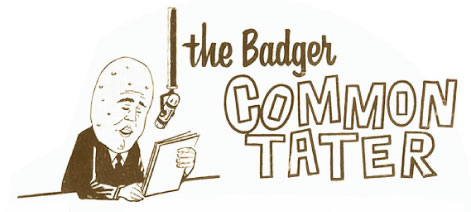In the August 2011 Badger Common’Tater
Potato Chip Pioneer: Fred Meyer, Founder of Red Dot Foods
Fred Meyer was in the chips—potato chips, that is. Back in 1931, he began selling potato chips out of the back seat of his car to put himself through college. By the early 1950s, he was piloting one of his four Cessna airplanes to his potato farms in Alabama, Missouri and Wisconsin, and to sales meetings, conferences and conventions throughout the nation. With plants in Madison, Rhinelander, Minneapolis and Indianapolis, Meyer’s Red Dot Foods, Inc., had sales of over $10 million a year by 1957. For the full story on this potato chip pioneer, see the August issue of The Badger Common’Tater.
Have Your Chip and Eat it Too!
Wisconsin researchers develop low sugar, low acrylamide potatoes

Some of the transgenic lines of low invertase potatoes are pictured in the greenhouse at the University of Wisconsin in January of 2011.
Recent research findings from the potato labs of UW researchers Jiming Jiang and Paul Bethke have demonstrated that low sugar contents can be maintained in tubers stored at temperatures as low as 39?F by simply turning off a single potato gene. Because the same sugars that contribute to dark color formation in chips and fries also contribute to acrylamide formation, this single approach can be used to simultaneously address the cold-induced sweetening and acrylamide problems. See the August issue of The Badger Common’Tater for more on this exciting potato research development.
Late Blight – Is resistance futile?
By Dennis Halterman
USDA/ARS Vegetable Crops Research Unit, Madison, WI
Every potato and tomato grower has probably lost sleep at some point worrying about the possibility of a late blight epidemic in their state, their county, or (in the worst case scenario) their own fields. The worries stem from the fact that, unless they are one of the few people growing resistant cultivars, the crop they have in the field looks like an all-you-can-eat buffet to a few hungry late blight spores. Unfortunately, the vast majority of potato varieties are late blight susceptible. This is likely due to a breeding “bottleneck” when potato was first introduced to Europe in the second half of the 16th century. The lack of genetic diversity among potatoes became apparent in the mid-1800’s during the Great Irish Potato Famine. Since then, breeders have been actively pursuing the development of late blight resistant varieties. Wild potato species have provided natural rich resistance sources against late blight. For more on this intriguing topic, check out the August Research Issue of The Badger Common’Tater.

